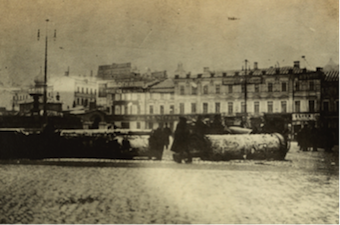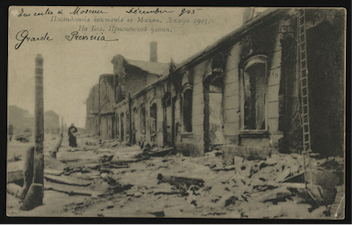

|
The Moscow Uprising  A barricade in the Moscow Uprising  Moscow after the uprising The October Manifesto did not satisfy the demands of the workers and peasants. There were renewed strikes and agrarian disturbances in the autumn. With the social revolution deepening, the Social Democrats resolved to stage an armed uprising in Moscow. Lenin had returned from Geneva in early November and was keen on a revolt. Under Trotsky's leadership, the Petersburg Soviet was also preparing for a showdown with the government. There was little prospect of success. When the Soviet leaders were arrested on 3 December, the Moscow Social Democrats declared a strike and distributed arms to the workers. Barricades went up and the streets of Moscow became a battlefield between the workers and police. More than a thousand civilians were killed in the suppression of the uprising. The prisons filled up, militant workers lost their jobs, and the socialist parties were forced underground. Slowly, through terror, order in the country was restored. The Moscow uprising was to occupy a prominent position in the Bolshevik cult of 1905: its 'fallen heroes' were commemorated as an inspiration by the revolutionaries of 1917. The uprising had been a failure but it stood as an example of the principle that Bolsheviks should act - risking failure - when it was possible to seize power. That was Lenin's principle in October 1917. |
© 2014 Orlando Figes | All Rights Reserved